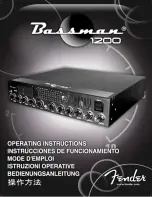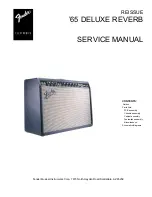
Single Zone Controller Amplifier
SP1200
oF 6 PAGES
5
O F 6 P A G E S
Architects’ and Engineers’ Specifications
The background music/paging processor shall be a
single zone unit that is expandable up to a total of 8/15
zones by adding up to seven additional units (SP1200/
SP2400) from the manufacturer that can be either single
or dual-zone processors. It shall consist of the following
sub-systems: (1) 4 stereo line-level inputs; (2) 3 micro-
phone inputs, one paging, one sound reinforcement, and
one ambient noise sensing; (3) a 3-band equalizer for the
line-level inputs; (4) a 2-band equalizer each for the pag-
ing and sound reinforcement microphone inputs; (5) a
transformerless 200 W power amplifier, capable of deliv-
ering full rated power into 70/100 V lines or 8-ohm
loads; (6) one auxiliary power amplifier input; (7) a signal
processing loop and two line-level outputs; (8) connec-
tors and circuitry for remote control of level, program
selection, and paging microphone priority; (9) an expan-
sion bus to carry balanced audio and control data to
other units in a multi-processor system; (10) an internal
RS485 port to re-flash the unit’s firmware.
The four line-level stereo inputs per zone shall be
unbalanced, terminated to RCA connectors and accept
nominal –10 dB signals. The stereo input signals shall
be internally mixed to mono and remain available to the
expansion bus in stereo. Selection of the active input
shall be from either a momentary push button on the
front panel or remotely from an accessory panel provided
by the manufacturer. In either case, the selected input
shall cross fade with the current program. When the pag-
ing microphone is activated, the current line-level pro-
gram shall attenuate to a level that is preset by a poten-
tiometer on the rear panel. DIP switches shall be pro-
vided to direct the line-level input signals to other units
(SP1200/SP2400) in a multi-processor system via the
expansion bus.
The paging microphone input shall be actively balanced,
accept a nominal signal between –52 dB and +4 dB that
is trimmed by means of a DIP switch on the rear panel. It
shall be terminated in a XLR connector that is paralleled
to a Phoenix-type connector. The input shall provide 24 V
phantom powering that is selected by a DIP switch on the
rear panel. The input shall be activated by either VOX or
a contact closure made at a connector on the rear panel.
The VOX level shall be set by a potentiometer on the rear
panel. A DIP switch shall be provided on the rear panel
to direct the paging microphone signal to other units in a
multi-processor system via the expansion bus.
The sound reinforcement microphone input shall be
actively balanced, accept a nominal signal between –52
dB and +4 dB that is trimmed by means of a DIP switch
on the rear panel. It shall be terminated in a XLR connec-
tor that is parallel to a Phoenix-type connector. The input
shall provide 24 V phantom powering that is selected by a
DIP switch on the rear panel. The input shall be activated
by a momentary switch on the front panel, an optional
remote control panel supplied by the manufacturer, or a
contact closure made at a connector on the rear panel.
The ambient noise sensing microphone input shall be
actively balanced, and accept a nominal signal between
–52 dB and +4 dB that is trimmed by means of a DIP
switch on the rear panel. It shall be terminated in a Phoenix-
type connector. The input shall provide 24 V phantom
powering that is selected by a DIP switch on the rear
panel. An optional ambient noise sensing microphone
shall be available from the manufacturer as an accessory.
Two-band equalization for the paging and sound rein-
forcement microphones and three-band equalization for
the line-level inputs shall be provided. All adjustments
shall be made by potentiometers on the rear panel. The
two-band equalizers shall have shelving filters at 100 Hz
and 10 kHz that can be adjusted ±12 dB. The three-band
equalizer shall have shelving filters at 80 Hz and 12 kHz
that can be adjusted ±12 dB and a ±12 dB mid-band filter
that is sweepable between 250 Hz and 8 kHz.
The integrated power amplifier shall produce a mini-
mum of 200 WRMS over a range of 20 Hz to 20 kHz with
no more than 0.01% distortion and drive either 70/100 V
constant voltage lines or a constant impedance load of
8 ohms, without having an output transformer. It shall
be protected from short circuit, overload conditions, and
extreme operating temperatures. One direct, unbalanced
line-level input to the amplifier shall be provided via RCA
connectors on the rear panel.
An expansion bus shall be provided to send and
receive balanced audio signals and control signals to
other units in a multi-processor system on 25 conductor,
shielded cable or industry standard computer cables ter-
minated with DB25 male connectors. Complete setup
control of a multi-processor system shall be possible
through the DIP switch settings and without an external
processor. An internal industry standard RS232 port shall
be included to re-flash the unit’s firmware using software
provided by the manufacturer.
The power supply shall be internal and connected to
50 or 60 Hz source current through a detachable IEC
power cord. It shall have an on/off switch and fuse hold-
er. The power supply shall draw a maximum of 5 A and
illuminate an indicator light when on.
The unit shall be self-contained in an aluminum and
steel chassis that can be mounted in a standard 19" EIA
rack using no more than 3.5" of vertical space. The back-
ground music/paging processor shall be a model SP1200
manufactured by Mackie Designs Inc.
























